Analyzing the Impact of Economic Factors on Market Structures
VerifiedAdded on 2020/04/29
|15
|4157
|299
AI Summary
The document provides a comprehensive analysis of how various economic factors shape market structures. It discusses the role of competition in mobile communications, the implications of regulatory changes, and the strategic responses by firms to evolving market dynamics. Key themes include the impact of deregulation on industry practices, pricing strategies in response to consumer behavior, and the significance of technological advancements in shaping competitive landscapes. The analysis draws upon a range of studies and theoretical models, highlighting the complexity of economic interactions within different industries.
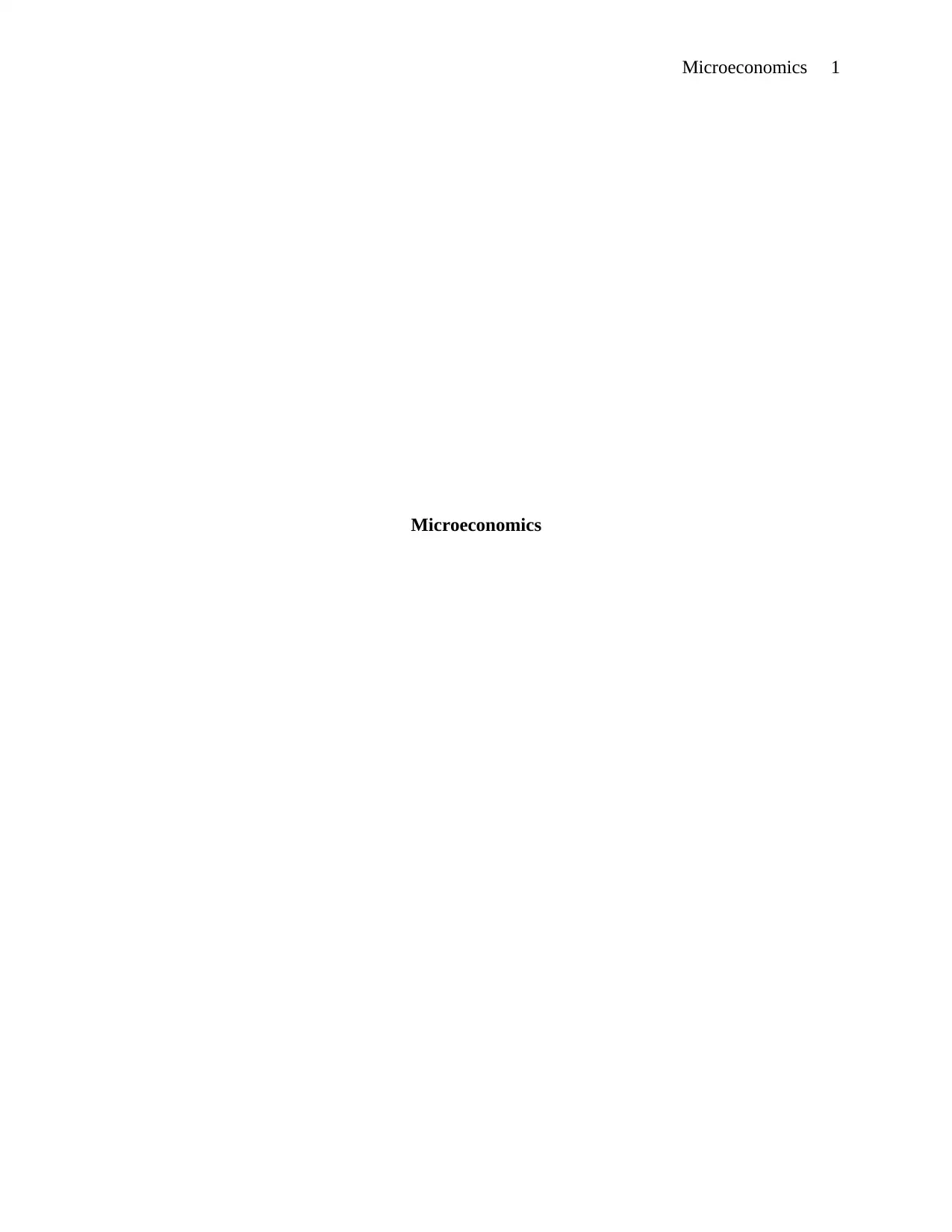
Microeconomics 1
Microeconomics
Microeconomics
Paraphrase This Document
Need a fresh take? Get an instant paraphrase of this document with our AI Paraphraser
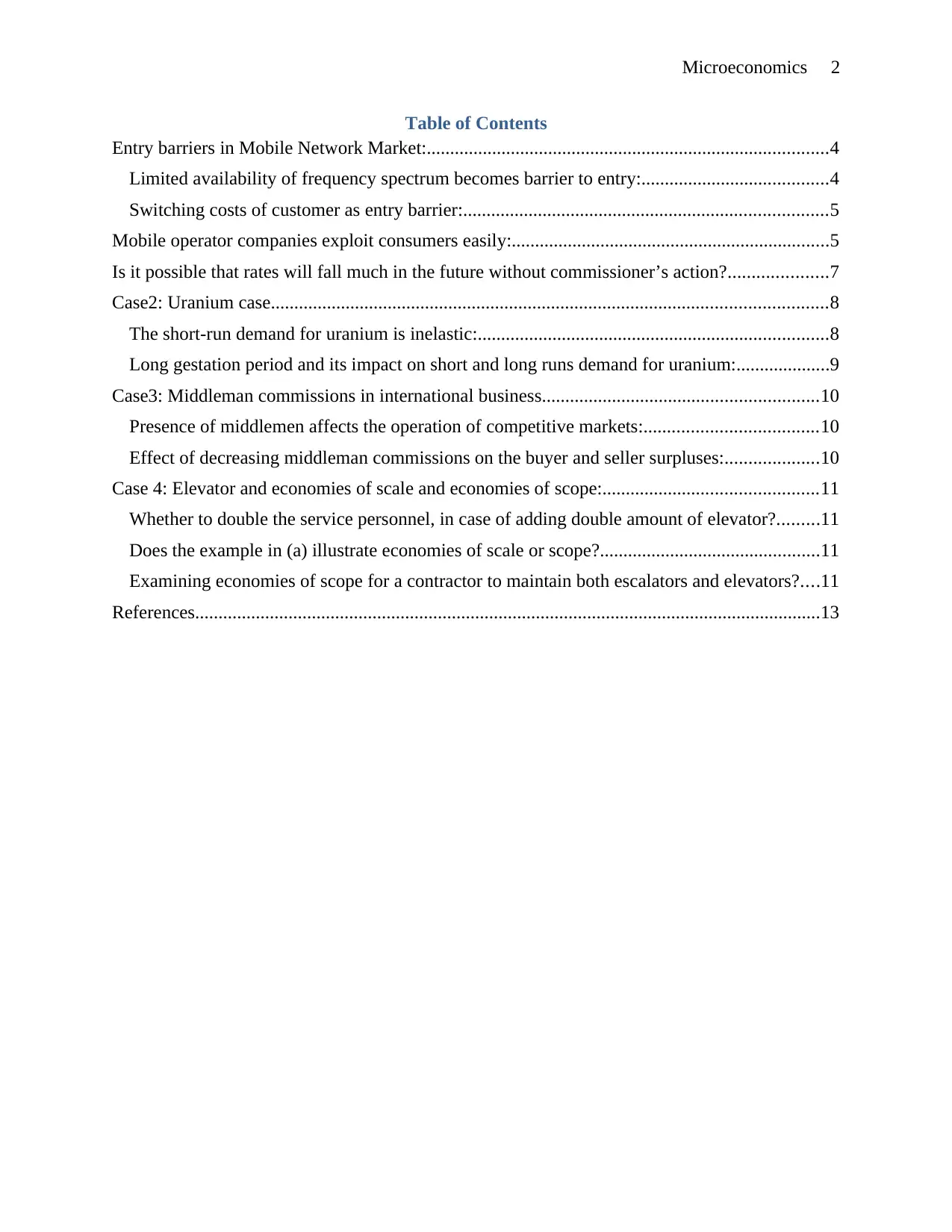
Microeconomics 2
Table of Contents
Entry barriers in Mobile Network Market:......................................................................................4
Limited availability of frequency spectrum becomes barrier to entry:........................................4
Switching costs of customer as entry barrier:..............................................................................5
Mobile operator companies exploit consumers easily:....................................................................5
Is it possible that rates will fall much in the future without commissioner’s action?.....................7
Case2: Uranium case.......................................................................................................................8
The short-run demand for uranium is inelastic:...........................................................................8
Long gestation period and its impact on short and long runs demand for uranium:....................9
Case3: Middleman commissions in international business...........................................................10
Presence of middlemen affects the operation of competitive markets:.....................................10
Effect of decreasing middleman commissions on the buyer and seller surpluses:....................10
Case 4: Elevator and economies of scale and economies of scope:..............................................11
Whether to double the service personnel, in case of adding double amount of elevator?.........11
Does the example in (a) illustrate economies of scale or scope?...............................................11
Examining economies of scope for a contractor to maintain both escalators and elevators?....11
References......................................................................................................................................13
Table of Contents
Entry barriers in Mobile Network Market:......................................................................................4
Limited availability of frequency spectrum becomes barrier to entry:........................................4
Switching costs of customer as entry barrier:..............................................................................5
Mobile operator companies exploit consumers easily:....................................................................5
Is it possible that rates will fall much in the future without commissioner’s action?.....................7
Case2: Uranium case.......................................................................................................................8
The short-run demand for uranium is inelastic:...........................................................................8
Long gestation period and its impact on short and long runs demand for uranium:....................9
Case3: Middleman commissions in international business...........................................................10
Presence of middlemen affects the operation of competitive markets:.....................................10
Effect of decreasing middleman commissions on the buyer and seller surpluses:....................10
Case 4: Elevator and economies of scale and economies of scope:..............................................11
Whether to double the service personnel, in case of adding double amount of elevator?.........11
Does the example in (a) illustrate economies of scale or scope?...............................................11
Examining economies of scope for a contractor to maintain both escalators and elevators?....11
References......................................................................................................................................13
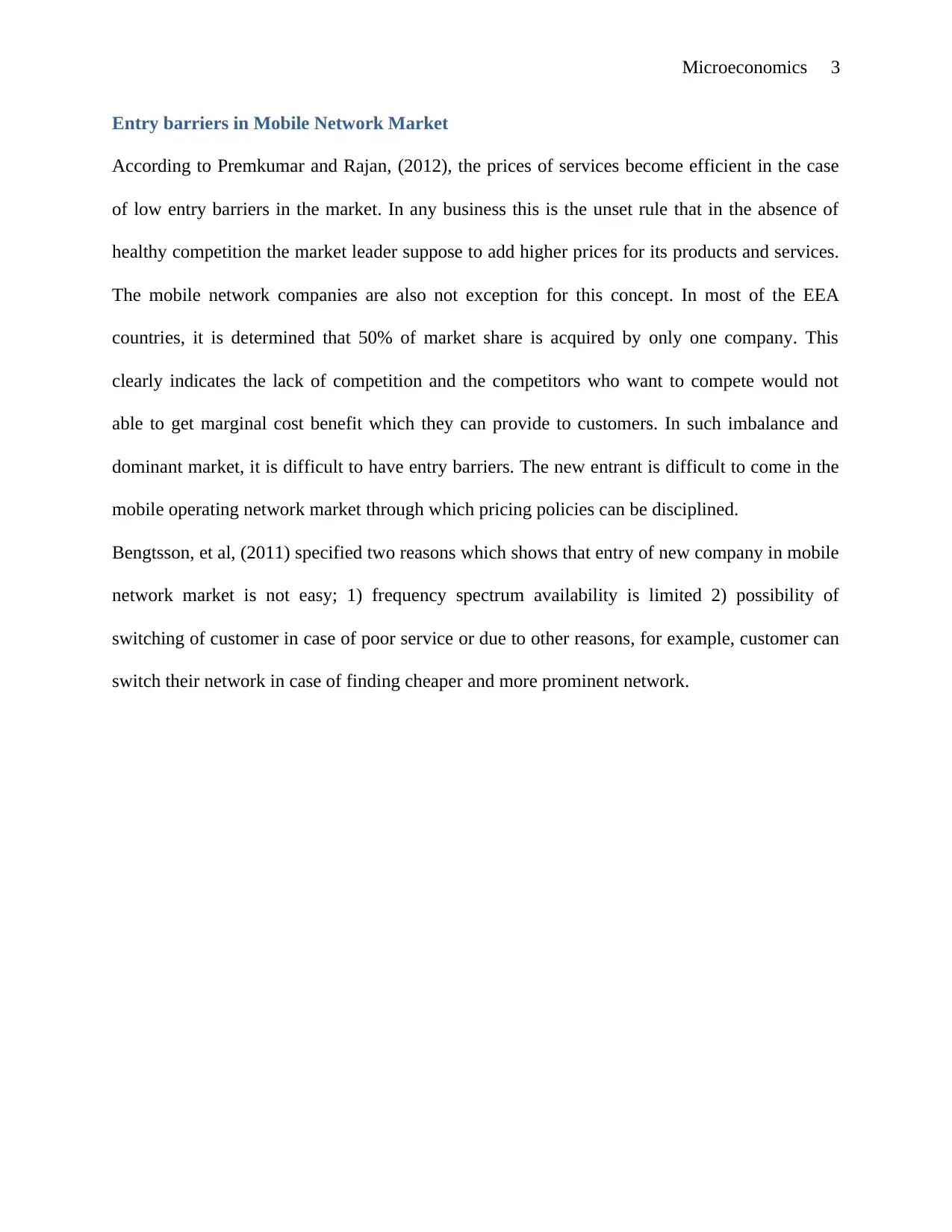
Microeconomics 3
Entry barriers in Mobile Network Market
According to Premkumar and Rajan, (2012), the prices of services become efficient in the case
of low entry barriers in the market. In any business this is the unset rule that in the absence of
healthy competition the market leader suppose to add higher prices for its products and services.
The mobile network companies are also not exception for this concept. In most of the EEA
countries, it is determined that 50% of market share is acquired by only one company. This
clearly indicates the lack of competition and the competitors who want to compete would not
able to get marginal cost benefit which they can provide to customers. In such imbalance and
dominant market, it is difficult to have entry barriers. The new entrant is difficult to come in the
mobile operating network market through which pricing policies can be disciplined.
Bengtsson, et al, (2011) specified two reasons which shows that entry of new company in mobile
network market is not easy; 1) frequency spectrum availability is limited 2) possibility of
switching of customer in case of poor service or due to other reasons, for example, customer can
switch their network in case of finding cheaper and more prominent network.
Entry barriers in Mobile Network Market
According to Premkumar and Rajan, (2012), the prices of services become efficient in the case
of low entry barriers in the market. In any business this is the unset rule that in the absence of
healthy competition the market leader suppose to add higher prices for its products and services.
The mobile network companies are also not exception for this concept. In most of the EEA
countries, it is determined that 50% of market share is acquired by only one company. This
clearly indicates the lack of competition and the competitors who want to compete would not
able to get marginal cost benefit which they can provide to customers. In such imbalance and
dominant market, it is difficult to have entry barriers. The new entrant is difficult to come in the
mobile operating network market through which pricing policies can be disciplined.
Bengtsson, et al, (2011) specified two reasons which shows that entry of new company in mobile
network market is not easy; 1) frequency spectrum availability is limited 2) possibility of
switching of customer in case of poor service or due to other reasons, for example, customer can
switch their network in case of finding cheaper and more prominent network.
⊘ This is a preview!⊘
Do you want full access?
Subscribe today to unlock all pages.

Trusted by 1+ million students worldwide
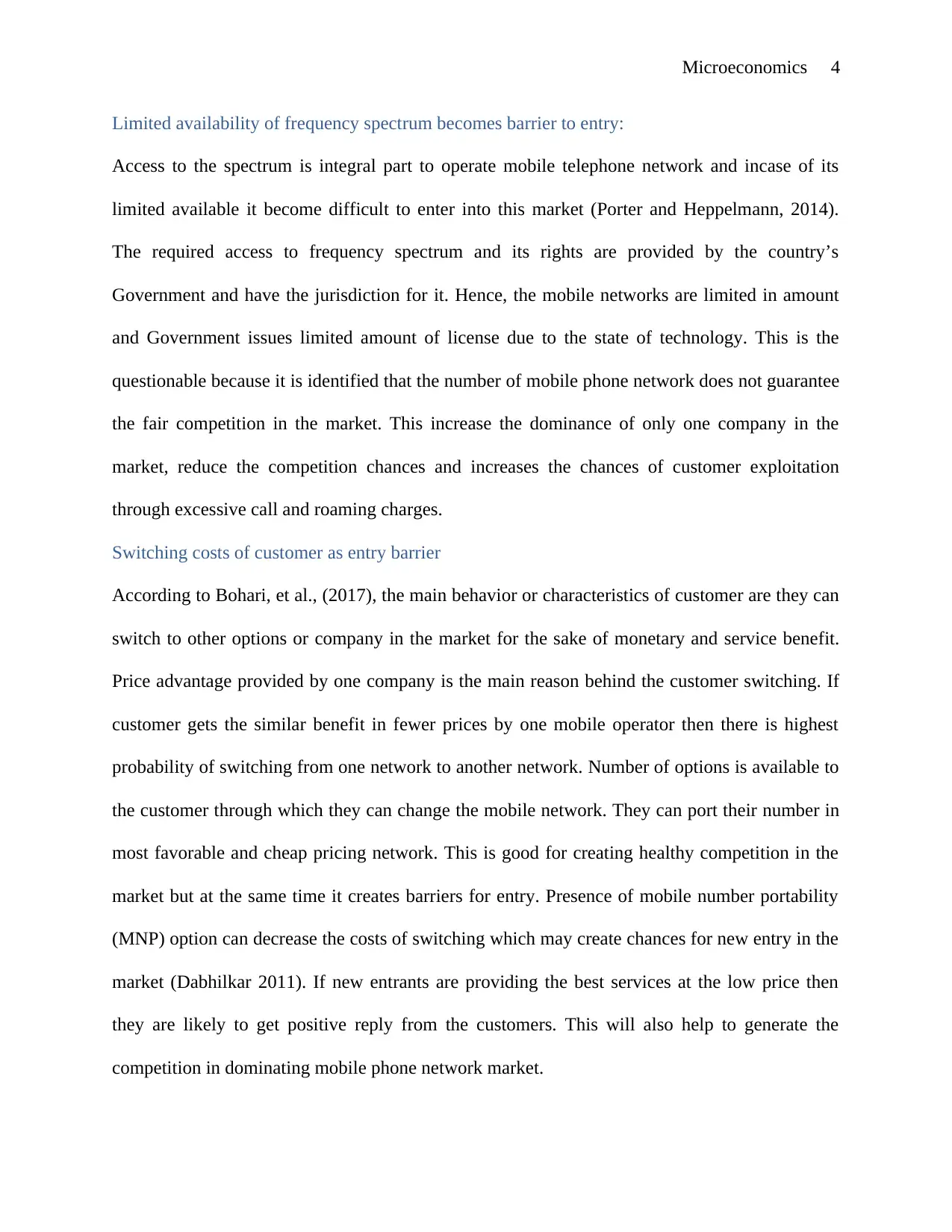
Microeconomics 4
Limited availability of frequency spectrum becomes barrier to entry:
Access to the spectrum is integral part to operate mobile telephone network and incase of its
limited available it become difficult to enter into this market (Porter and Heppelmann, 2014).
The required access to frequency spectrum and its rights are provided by the country’s
Government and have the jurisdiction for it. Hence, the mobile networks are limited in amount
and Government issues limited amount of license due to the state of technology. This is the
questionable because it is identified that the number of mobile phone network does not guarantee
the fair competition in the market. This increase the dominance of only one company in the
market, reduce the competition chances and increases the chances of customer exploitation
through excessive call and roaming charges.
Switching costs of customer as entry barrier
According to Bohari, et al., (2017), the main behavior or characteristics of customer are they can
switch to other options or company in the market for the sake of monetary and service benefit.
Price advantage provided by one company is the main reason behind the customer switching. If
customer gets the similar benefit in fewer prices by one mobile operator then there is highest
probability of switching from one network to another network. Number of options is available to
the customer through which they can change the mobile network. They can port their number in
most favorable and cheap pricing network. This is good for creating healthy competition in the
market but at the same time it creates barriers for entry. Presence of mobile number portability
(MNP) option can decrease the costs of switching which may create chances for new entry in the
market (Dabhilkar 2011). If new entrants are providing the best services at the low price then
they are likely to get positive reply from the customers. This will also help to generate the
competition in dominating mobile phone network market.
Limited availability of frequency spectrum becomes barrier to entry:
Access to the spectrum is integral part to operate mobile telephone network and incase of its
limited available it become difficult to enter into this market (Porter and Heppelmann, 2014).
The required access to frequency spectrum and its rights are provided by the country’s
Government and have the jurisdiction for it. Hence, the mobile networks are limited in amount
and Government issues limited amount of license due to the state of technology. This is the
questionable because it is identified that the number of mobile phone network does not guarantee
the fair competition in the market. This increase the dominance of only one company in the
market, reduce the competition chances and increases the chances of customer exploitation
through excessive call and roaming charges.
Switching costs of customer as entry barrier
According to Bohari, et al., (2017), the main behavior or characteristics of customer are they can
switch to other options or company in the market for the sake of monetary and service benefit.
Price advantage provided by one company is the main reason behind the customer switching. If
customer gets the similar benefit in fewer prices by one mobile operator then there is highest
probability of switching from one network to another network. Number of options is available to
the customer through which they can change the mobile network. They can port their number in
most favorable and cheap pricing network. This is good for creating healthy competition in the
market but at the same time it creates barriers for entry. Presence of mobile number portability
(MNP) option can decrease the costs of switching which may create chances for new entry in the
market (Dabhilkar 2011). If new entrants are providing the best services at the low price then
they are likely to get positive reply from the customers. This will also help to generate the
competition in dominating mobile phone network market.
Paraphrase This Document
Need a fresh take? Get an instant paraphrase of this document with our AI Paraphraser
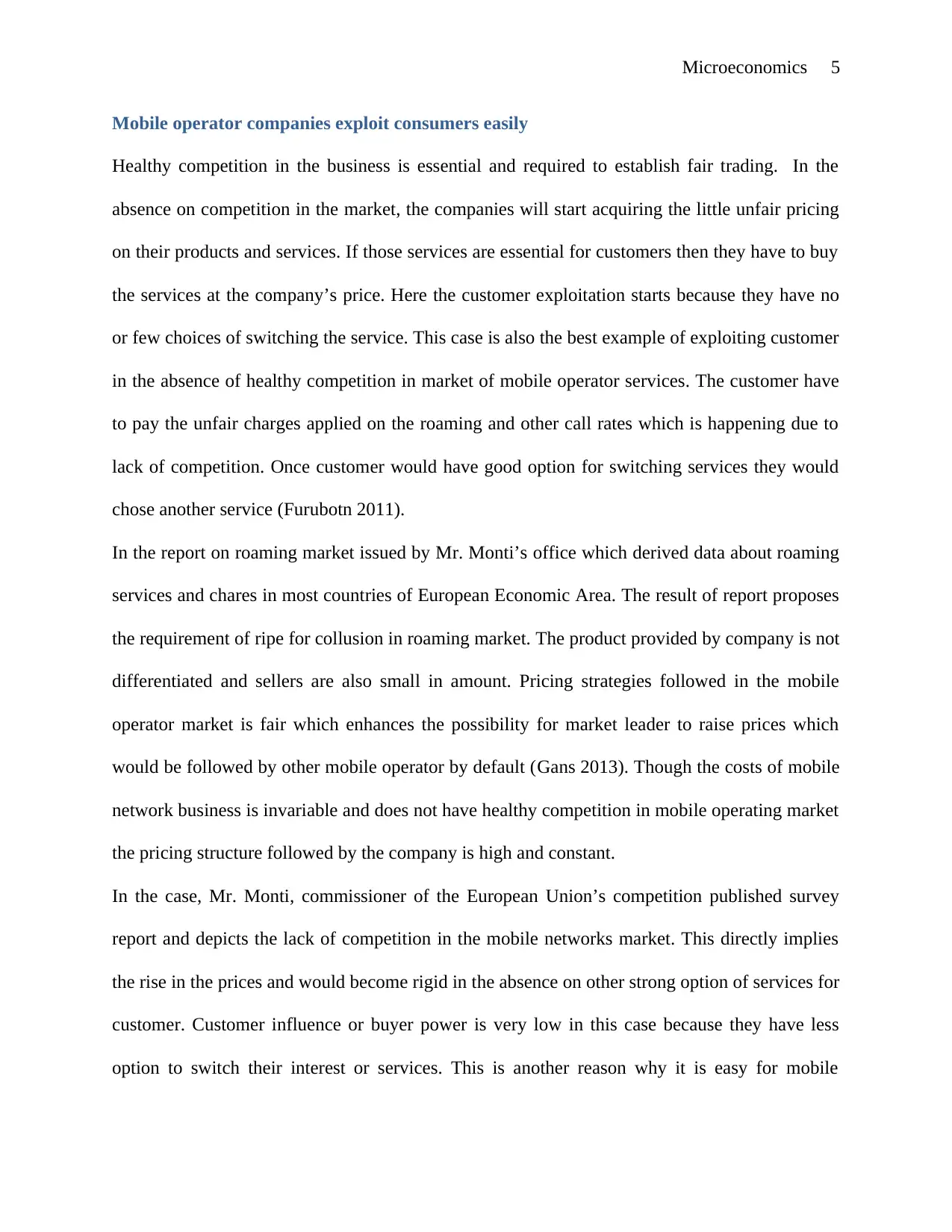
Microeconomics 5
Mobile operator companies exploit consumers easily
Healthy competition in the business is essential and required to establish fair trading. In the
absence on competition in the market, the companies will start acquiring the little unfair pricing
on their products and services. If those services are essential for customers then they have to buy
the services at the company’s price. Here the customer exploitation starts because they have no
or few choices of switching the service. This case is also the best example of exploiting customer
in the absence of healthy competition in market of mobile operator services. The customer have
to pay the unfair charges applied on the roaming and other call rates which is happening due to
lack of competition. Once customer would have good option for switching services they would
chose another service (Furubotn 2011).
In the report on roaming market issued by Mr. Monti’s office which derived data about roaming
services and chares in most countries of European Economic Area. The result of report proposes
the requirement of ripe for collusion in roaming market. The product provided by company is not
differentiated and sellers are also small in amount. Pricing strategies followed in the mobile
operator market is fair which enhances the possibility for market leader to raise prices which
would be followed by other mobile operator by default (Gans 2013). Though the costs of mobile
network business is invariable and does not have healthy competition in mobile operating market
the pricing structure followed by the company is high and constant.
In the case, Mr. Monti, commissioner of the European Union’s competition published survey
report and depicts the lack of competition in the mobile networks market. This directly implies
the rise in the prices and would become rigid in the absence on other strong option of services for
customer. Customer influence or buyer power is very low in this case because they have less
option to switch their interest or services. This is another reason why it is easy for mobile
Mobile operator companies exploit consumers easily
Healthy competition in the business is essential and required to establish fair trading. In the
absence on competition in the market, the companies will start acquiring the little unfair pricing
on their products and services. If those services are essential for customers then they have to buy
the services at the company’s price. Here the customer exploitation starts because they have no
or few choices of switching the service. This case is also the best example of exploiting customer
in the absence of healthy competition in market of mobile operator services. The customer have
to pay the unfair charges applied on the roaming and other call rates which is happening due to
lack of competition. Once customer would have good option for switching services they would
chose another service (Furubotn 2011).
In the report on roaming market issued by Mr. Monti’s office which derived data about roaming
services and chares in most countries of European Economic Area. The result of report proposes
the requirement of ripe for collusion in roaming market. The product provided by company is not
differentiated and sellers are also small in amount. Pricing strategies followed in the mobile
operator market is fair which enhances the possibility for market leader to raise prices which
would be followed by other mobile operator by default (Gans 2013). Though the costs of mobile
network business is invariable and does not have healthy competition in mobile operating market
the pricing structure followed by the company is high and constant.
In the case, Mr. Monti, commissioner of the European Union’s competition published survey
report and depicts the lack of competition in the mobile networks market. This directly implies
the rise in the prices and would become rigid in the absence on other strong option of services for
customer. Customer influence or buyer power is very low in this case because they have less
option to switch their interest or services. This is another reason why it is easy for mobile
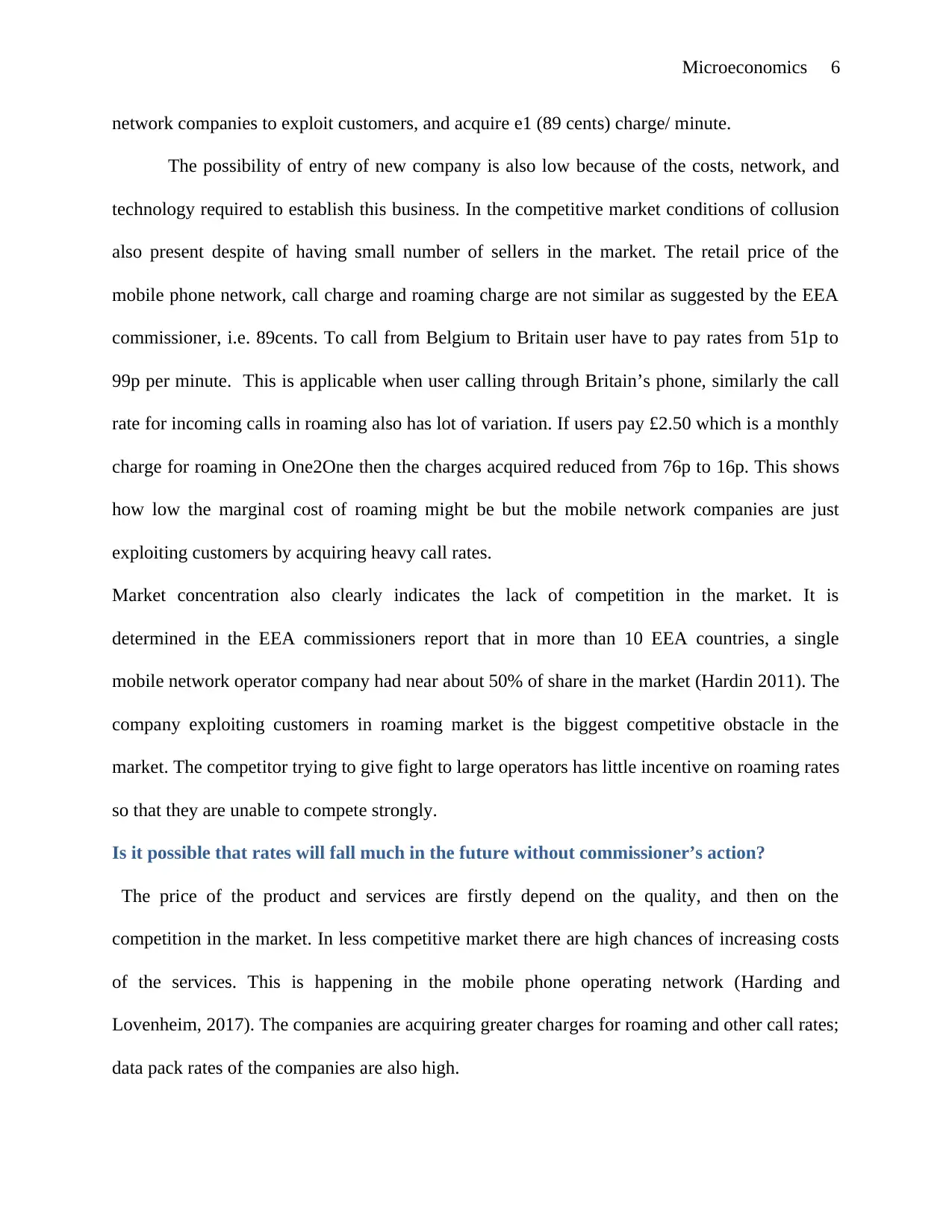
Microeconomics 6
network companies to exploit customers, and acquire e1 (89 cents) charge/ minute.
The possibility of entry of new company is also low because of the costs, network, and
technology required to establish this business. In the competitive market conditions of collusion
also present despite of having small number of sellers in the market. The retail price of the
mobile phone network, call charge and roaming charge are not similar as suggested by the EEA
commissioner, i.e. 89cents. To call from Belgium to Britain user have to pay rates from 51p to
99p per minute. This is applicable when user calling through Britain’s phone, similarly the call
rate for incoming calls in roaming also has lot of variation. If users pay £2.50 which is a monthly
charge for roaming in One2One then the charges acquired reduced from 76p to 16p. This shows
how low the marginal cost of roaming might be but the mobile network companies are just
exploiting customers by acquiring heavy call rates.
Market concentration also clearly indicates the lack of competition in the market. It is
determined in the EEA commissioners report that in more than 10 EEA countries, a single
mobile network operator company had near about 50% of share in the market (Hardin 2011). The
company exploiting customers in roaming market is the biggest competitive obstacle in the
market. The competitor trying to give fight to large operators has little incentive on roaming rates
so that they are unable to compete strongly.
Is it possible that rates will fall much in the future without commissioner’s action?
The price of the product and services are firstly depend on the quality, and then on the
competition in the market. In less competitive market there are high chances of increasing costs
of the services. This is happening in the mobile phone operating network (Harding and
Lovenheim, 2017). The companies are acquiring greater charges for roaming and other call rates;
data pack rates of the companies are also high.
network companies to exploit customers, and acquire e1 (89 cents) charge/ minute.
The possibility of entry of new company is also low because of the costs, network, and
technology required to establish this business. In the competitive market conditions of collusion
also present despite of having small number of sellers in the market. The retail price of the
mobile phone network, call charge and roaming charge are not similar as suggested by the EEA
commissioner, i.e. 89cents. To call from Belgium to Britain user have to pay rates from 51p to
99p per minute. This is applicable when user calling through Britain’s phone, similarly the call
rate for incoming calls in roaming also has lot of variation. If users pay £2.50 which is a monthly
charge for roaming in One2One then the charges acquired reduced from 76p to 16p. This shows
how low the marginal cost of roaming might be but the mobile network companies are just
exploiting customers by acquiring heavy call rates.
Market concentration also clearly indicates the lack of competition in the market. It is
determined in the EEA commissioners report that in more than 10 EEA countries, a single
mobile network operator company had near about 50% of share in the market (Hardin 2011). The
company exploiting customers in roaming market is the biggest competitive obstacle in the
market. The competitor trying to give fight to large operators has little incentive on roaming rates
so that they are unable to compete strongly.
Is it possible that rates will fall much in the future without commissioner’s action?
The price of the product and services are firstly depend on the quality, and then on the
competition in the market. In less competitive market there are high chances of increasing costs
of the services. This is happening in the mobile phone operating network (Harding and
Lovenheim, 2017). The companies are acquiring greater charges for roaming and other call rates;
data pack rates of the companies are also high.
⊘ This is a preview!⊘
Do you want full access?
Subscribe today to unlock all pages.

Trusted by 1+ million students worldwide
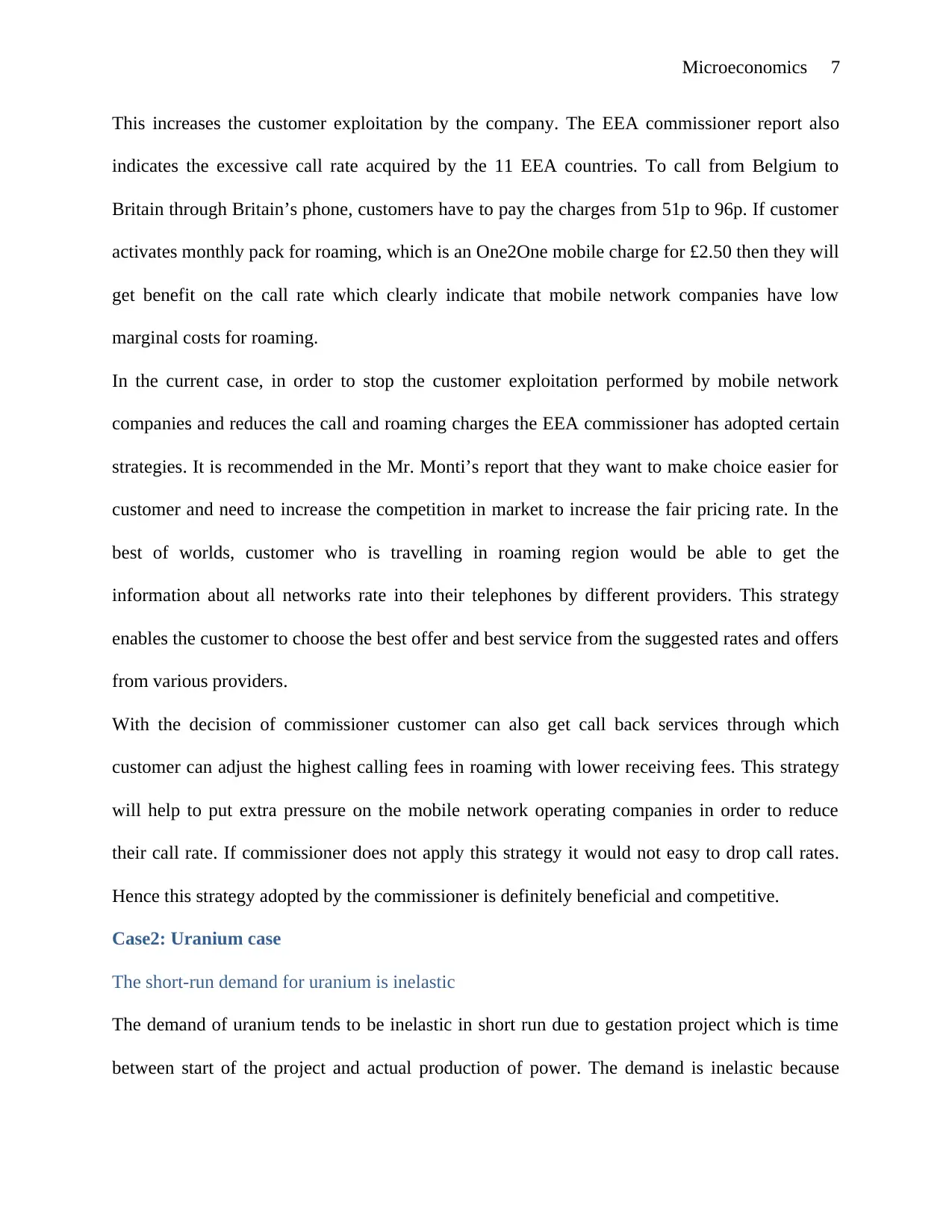
Microeconomics 7
This increases the customer exploitation by the company. The EEA commissioner report also
indicates the excessive call rate acquired by the 11 EEA countries. To call from Belgium to
Britain through Britain’s phone, customers have to pay the charges from 51p to 96p. If customer
activates monthly pack for roaming, which is an One2One mobile charge for £2.50 then they will
get benefit on the call rate which clearly indicate that mobile network companies have low
marginal costs for roaming.
In the current case, in order to stop the customer exploitation performed by mobile network
companies and reduces the call and roaming charges the EEA commissioner has adopted certain
strategies. It is recommended in the Mr. Monti’s report that they want to make choice easier for
customer and need to increase the competition in market to increase the fair pricing rate. In the
best of worlds, customer who is travelling in roaming region would be able to get the
information about all networks rate into their telephones by different providers. This strategy
enables the customer to choose the best offer and best service from the suggested rates and offers
from various providers.
With the decision of commissioner customer can also get call back services through which
customer can adjust the highest calling fees in roaming with lower receiving fees. This strategy
will help to put extra pressure on the mobile network operating companies in order to reduce
their call rate. If commissioner does not apply this strategy it would not easy to drop call rates.
Hence this strategy adopted by the commissioner is definitely beneficial and competitive.
Case2: Uranium case
The short-run demand for uranium is inelastic
The demand of uranium tends to be inelastic in short run due to gestation project which is time
between start of the project and actual production of power. The demand is inelastic because
This increases the customer exploitation by the company. The EEA commissioner report also
indicates the excessive call rate acquired by the 11 EEA countries. To call from Belgium to
Britain through Britain’s phone, customers have to pay the charges from 51p to 96p. If customer
activates monthly pack for roaming, which is an One2One mobile charge for £2.50 then they will
get benefit on the call rate which clearly indicate that mobile network companies have low
marginal costs for roaming.
In the current case, in order to stop the customer exploitation performed by mobile network
companies and reduces the call and roaming charges the EEA commissioner has adopted certain
strategies. It is recommended in the Mr. Monti’s report that they want to make choice easier for
customer and need to increase the competition in market to increase the fair pricing rate. In the
best of worlds, customer who is travelling in roaming region would be able to get the
information about all networks rate into their telephones by different providers. This strategy
enables the customer to choose the best offer and best service from the suggested rates and offers
from various providers.
With the decision of commissioner customer can also get call back services through which
customer can adjust the highest calling fees in roaming with lower receiving fees. This strategy
will help to put extra pressure on the mobile network operating companies in order to reduce
their call rate. If commissioner does not apply this strategy it would not easy to drop call rates.
Hence this strategy adopted by the commissioner is definitely beneficial and competitive.
Case2: Uranium case
The short-run demand for uranium is inelastic
The demand of uranium tends to be inelastic in short run due to gestation project which is time
between start of the project and actual production of power. The demand is inelastic because
Paraphrase This Document
Need a fresh take? Get an instant paraphrase of this document with our AI Paraphraser
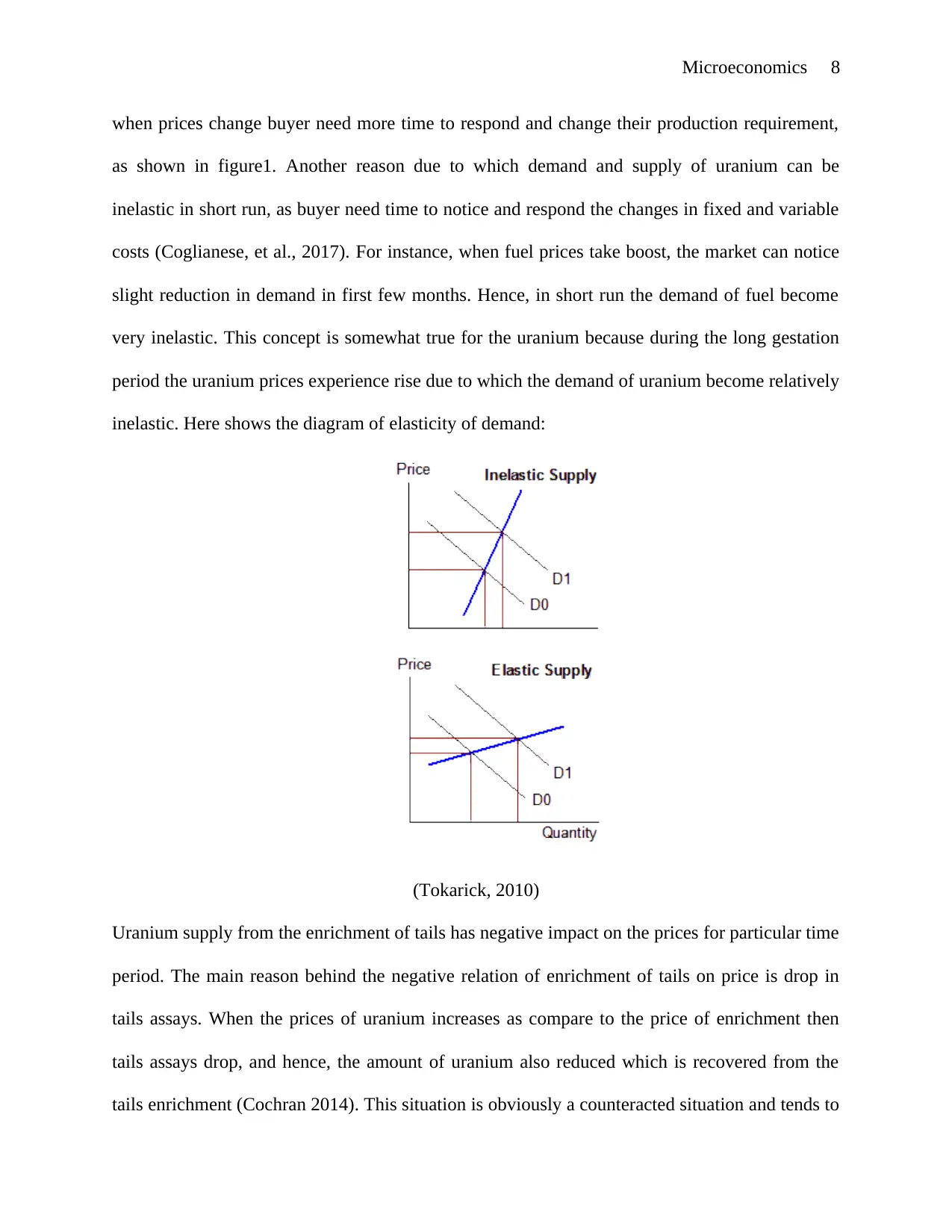
Microeconomics 8
when prices change buyer need more time to respond and change their production requirement,
as shown in figure1. Another reason due to which demand and supply of uranium can be
inelastic in short run, as buyer need time to notice and respond the changes in fixed and variable
costs (Coglianese, et al., 2017). For instance, when fuel prices take boost, the market can notice
slight reduction in demand in first few months. Hence, in short run the demand of fuel become
very inelastic. This concept is somewhat true for the uranium because during the long gestation
period the uranium prices experience rise due to which the demand of uranium become relatively
inelastic. Here shows the diagram of elasticity of demand:
(Tokarick, 2010)
Uranium supply from the enrichment of tails has negative impact on the prices for particular time
period. The main reason behind the negative relation of enrichment of tails on price is drop in
tails assays. When the prices of uranium increases as compare to the price of enrichment then
tails assays drop, and hence, the amount of uranium also reduced which is recovered from the
tails enrichment (Cochran 2014). This situation is obviously a counteracted situation and tends to
when prices change buyer need more time to respond and change their production requirement,
as shown in figure1. Another reason due to which demand and supply of uranium can be
inelastic in short run, as buyer need time to notice and respond the changes in fixed and variable
costs (Coglianese, et al., 2017). For instance, when fuel prices take boost, the market can notice
slight reduction in demand in first few months. Hence, in short run the demand of fuel become
very inelastic. This concept is somewhat true for the uranium because during the long gestation
period the uranium prices experience rise due to which the demand of uranium become relatively
inelastic. Here shows the diagram of elasticity of demand:
(Tokarick, 2010)
Uranium supply from the enrichment of tails has negative impact on the prices for particular time
period. The main reason behind the negative relation of enrichment of tails on price is drop in
tails assays. When the prices of uranium increases as compare to the price of enrichment then
tails assays drop, and hence, the amount of uranium also reduced which is recovered from the
tails enrichment (Cochran 2014). This situation is obviously a counteracted situation and tends to
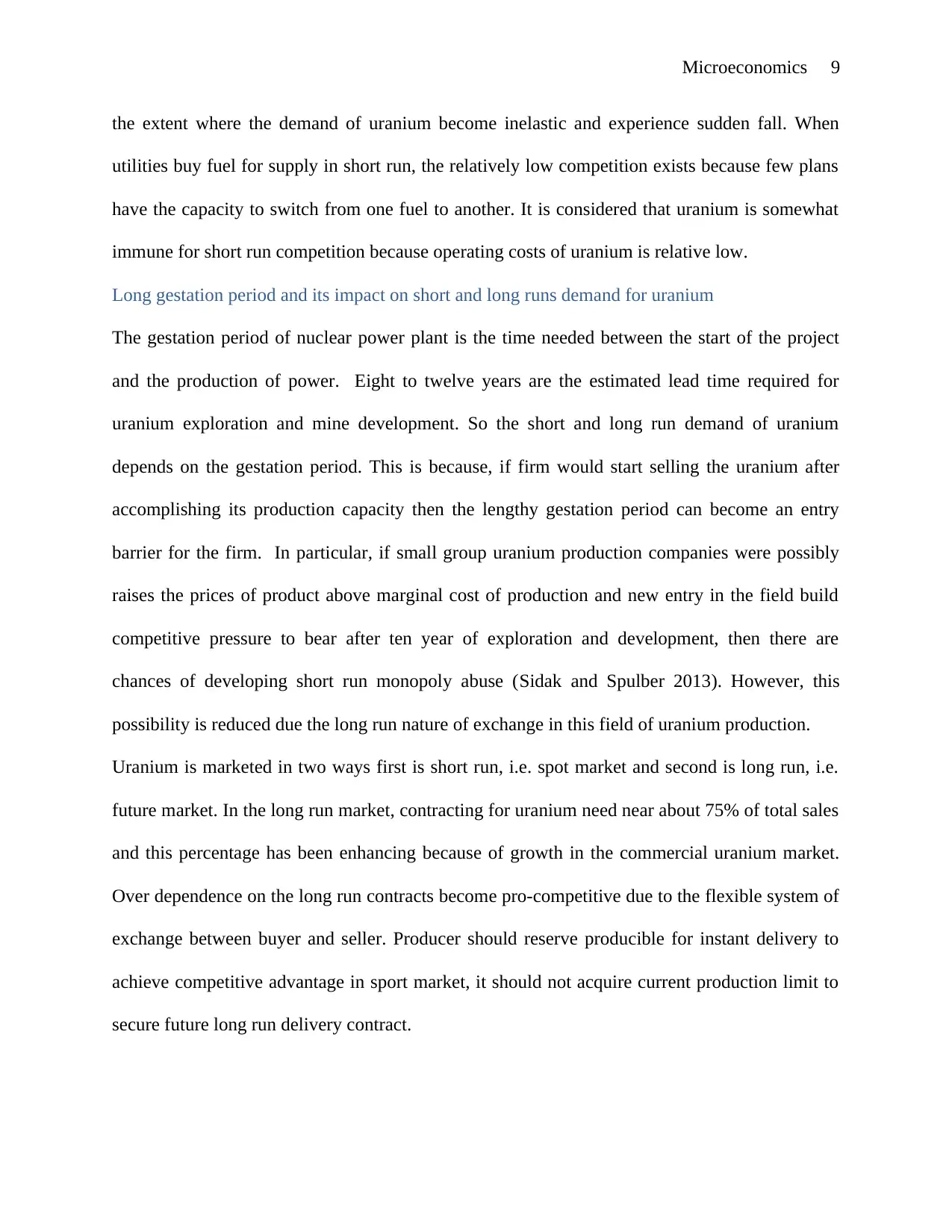
Microeconomics 9
the extent where the demand of uranium become inelastic and experience sudden fall. When
utilities buy fuel for supply in short run, the relatively low competition exists because few plans
have the capacity to switch from one fuel to another. It is considered that uranium is somewhat
immune for short run competition because operating costs of uranium is relative low.
Long gestation period and its impact on short and long runs demand for uranium
The gestation period of nuclear power plant is the time needed between the start of the project
and the production of power. Eight to twelve years are the estimated lead time required for
uranium exploration and mine development. So the short and long run demand of uranium
depends on the gestation period. This is because, if firm would start selling the uranium after
accomplishing its production capacity then the lengthy gestation period can become an entry
barrier for the firm. In particular, if small group uranium production companies were possibly
raises the prices of product above marginal cost of production and new entry in the field build
competitive pressure to bear after ten year of exploration and development, then there are
chances of developing short run monopoly abuse (Sidak and Spulber 2013). However, this
possibility is reduced due the long run nature of exchange in this field of uranium production.
Uranium is marketed in two ways first is short run, i.e. spot market and second is long run, i.e.
future market. In the long run market, contracting for uranium need near about 75% of total sales
and this percentage has been enhancing because of growth in the commercial uranium market.
Over dependence on the long run contracts become pro-competitive due to the flexible system of
exchange between buyer and seller. Producer should reserve producible for instant delivery to
achieve competitive advantage in sport market, it should not acquire current production limit to
secure future long run delivery contract.
the extent where the demand of uranium become inelastic and experience sudden fall. When
utilities buy fuel for supply in short run, the relatively low competition exists because few plans
have the capacity to switch from one fuel to another. It is considered that uranium is somewhat
immune for short run competition because operating costs of uranium is relative low.
Long gestation period and its impact on short and long runs demand for uranium
The gestation period of nuclear power plant is the time needed between the start of the project
and the production of power. Eight to twelve years are the estimated lead time required for
uranium exploration and mine development. So the short and long run demand of uranium
depends on the gestation period. This is because, if firm would start selling the uranium after
accomplishing its production capacity then the lengthy gestation period can become an entry
barrier for the firm. In particular, if small group uranium production companies were possibly
raises the prices of product above marginal cost of production and new entry in the field build
competitive pressure to bear after ten year of exploration and development, then there are
chances of developing short run monopoly abuse (Sidak and Spulber 2013). However, this
possibility is reduced due the long run nature of exchange in this field of uranium production.
Uranium is marketed in two ways first is short run, i.e. spot market and second is long run, i.e.
future market. In the long run market, contracting for uranium need near about 75% of total sales
and this percentage has been enhancing because of growth in the commercial uranium market.
Over dependence on the long run contracts become pro-competitive due to the flexible system of
exchange between buyer and seller. Producer should reserve producible for instant delivery to
achieve competitive advantage in sport market, it should not acquire current production limit to
secure future long run delivery contract.
⊘ This is a preview!⊘
Do you want full access?
Subscribe today to unlock all pages.

Trusted by 1+ million students worldwide
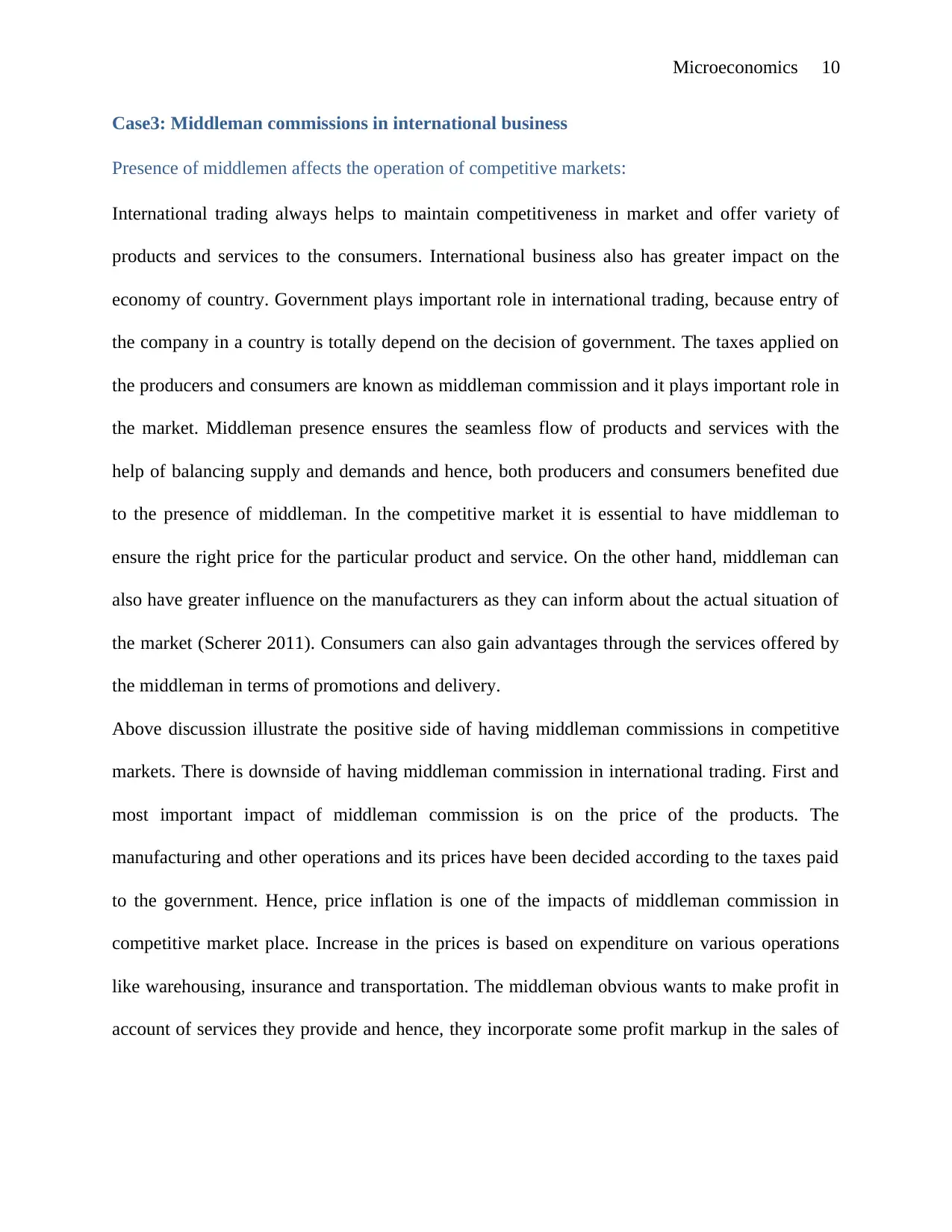
Microeconomics 10
Case3: Middleman commissions in international business
Presence of middlemen affects the operation of competitive markets:
International trading always helps to maintain competitiveness in market and offer variety of
products and services to the consumers. International business also has greater impact on the
economy of country. Government plays important role in international trading, because entry of
the company in a country is totally depend on the decision of government. The taxes applied on
the producers and consumers are known as middleman commission and it plays important role in
the market. Middleman presence ensures the seamless flow of products and services with the
help of balancing supply and demands and hence, both producers and consumers benefited due
to the presence of middleman. In the competitive market it is essential to have middleman to
ensure the right price for the particular product and service. On the other hand, middleman can
also have greater influence on the manufacturers as they can inform about the actual situation of
the market (Scherer 2011). Consumers can also gain advantages through the services offered by
the middleman in terms of promotions and delivery.
Above discussion illustrate the positive side of having middleman commissions in competitive
markets. There is downside of having middleman commission in international trading. First and
most important impact of middleman commission is on the price of the products. The
manufacturing and other operations and its prices have been decided according to the taxes paid
to the government. Hence, price inflation is one of the impacts of middleman commission in
competitive market place. Increase in the prices is based on expenditure on various operations
like warehousing, insurance and transportation. The middleman obvious wants to make profit in
account of services they provide and hence, they incorporate some profit markup in the sales of
Case3: Middleman commissions in international business
Presence of middlemen affects the operation of competitive markets:
International trading always helps to maintain competitiveness in market and offer variety of
products and services to the consumers. International business also has greater impact on the
economy of country. Government plays important role in international trading, because entry of
the company in a country is totally depend on the decision of government. The taxes applied on
the producers and consumers are known as middleman commission and it plays important role in
the market. Middleman presence ensures the seamless flow of products and services with the
help of balancing supply and demands and hence, both producers and consumers benefited due
to the presence of middleman. In the competitive market it is essential to have middleman to
ensure the right price for the particular product and service. On the other hand, middleman can
also have greater influence on the manufacturers as they can inform about the actual situation of
the market (Scherer 2011). Consumers can also gain advantages through the services offered by
the middleman in terms of promotions and delivery.
Above discussion illustrate the positive side of having middleman commissions in competitive
markets. There is downside of having middleman commission in international trading. First and
most important impact of middleman commission is on the price of the products. The
manufacturing and other operations and its prices have been decided according to the taxes paid
to the government. Hence, price inflation is one of the impacts of middleman commission in
competitive market place. Increase in the prices is based on expenditure on various operations
like warehousing, insurance and transportation. The middleman obvious wants to make profit in
account of services they provide and hence, they incorporate some profit markup in the sales of
Paraphrase This Document
Need a fresh take? Get an instant paraphrase of this document with our AI Paraphraser
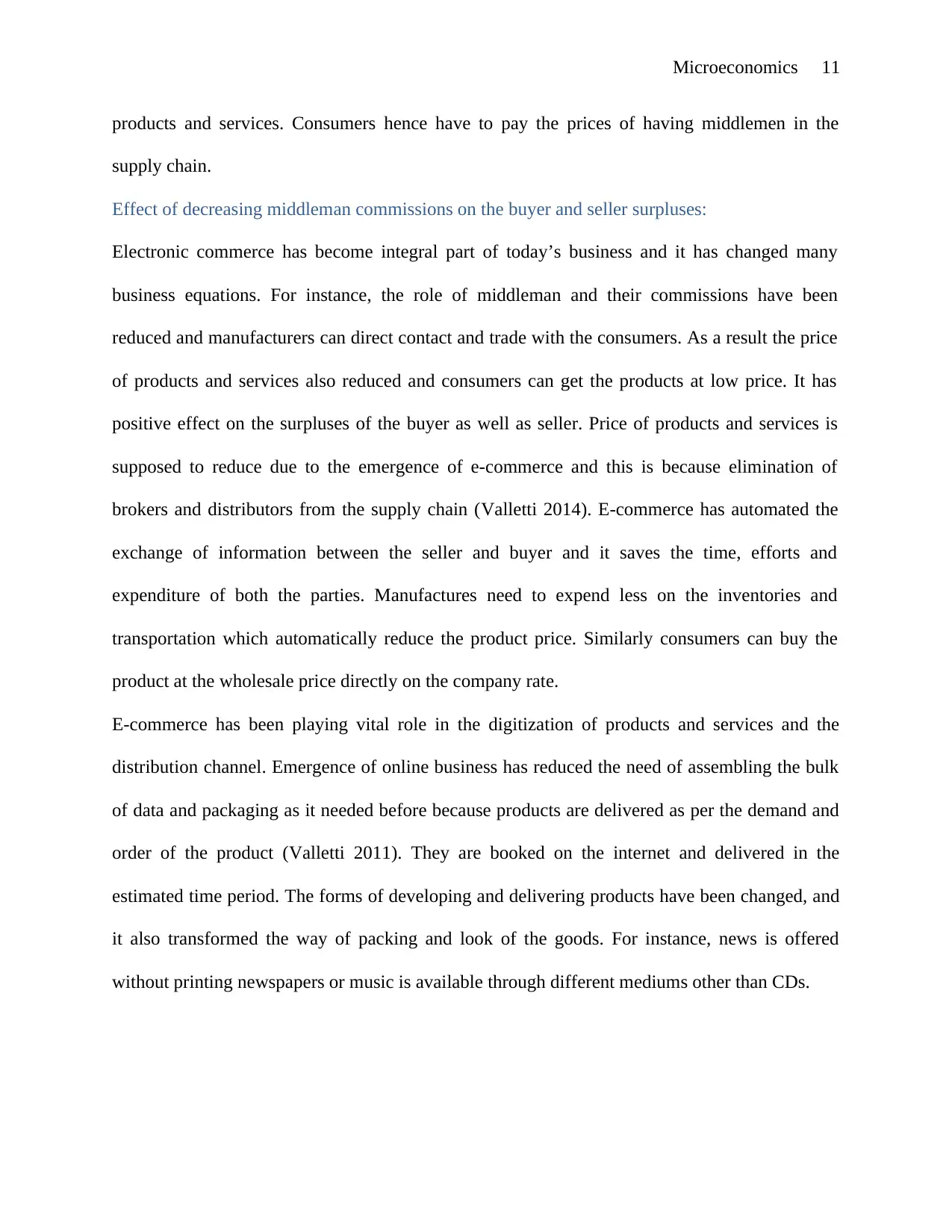
Microeconomics 11
products and services. Consumers hence have to pay the prices of having middlemen in the
supply chain.
Effect of decreasing middleman commissions on the buyer and seller surpluses:
Electronic commerce has become integral part of today’s business and it has changed many
business equations. For instance, the role of middleman and their commissions have been
reduced and manufacturers can direct contact and trade with the consumers. As a result the price
of products and services also reduced and consumers can get the products at low price. It has
positive effect on the surpluses of the buyer as well as seller. Price of products and services is
supposed to reduce due to the emergence of e-commerce and this is because elimination of
brokers and distributors from the supply chain (Valletti 2014). E-commerce has automated the
exchange of information between the seller and buyer and it saves the time, efforts and
expenditure of both the parties. Manufactures need to expend less on the inventories and
transportation which automatically reduce the product price. Similarly consumers can buy the
product at the wholesale price directly on the company rate.
E-commerce has been playing vital role in the digitization of products and services and the
distribution channel. Emergence of online business has reduced the need of assembling the bulk
of data and packaging as it needed before because products are delivered as per the demand and
order of the product (Valletti 2011). They are booked on the internet and delivered in the
estimated time period. The forms of developing and delivering products have been changed, and
it also transformed the way of packing and look of the goods. For instance, news is offered
without printing newspapers or music is available through different mediums other than CDs.
products and services. Consumers hence have to pay the prices of having middlemen in the
supply chain.
Effect of decreasing middleman commissions on the buyer and seller surpluses:
Electronic commerce has become integral part of today’s business and it has changed many
business equations. For instance, the role of middleman and their commissions have been
reduced and manufacturers can direct contact and trade with the consumers. As a result the price
of products and services also reduced and consumers can get the products at low price. It has
positive effect on the surpluses of the buyer as well as seller. Price of products and services is
supposed to reduce due to the emergence of e-commerce and this is because elimination of
brokers and distributors from the supply chain (Valletti 2014). E-commerce has automated the
exchange of information between the seller and buyer and it saves the time, efforts and
expenditure of both the parties. Manufactures need to expend less on the inventories and
transportation which automatically reduce the product price. Similarly consumers can buy the
product at the wholesale price directly on the company rate.
E-commerce has been playing vital role in the digitization of products and services and the
distribution channel. Emergence of online business has reduced the need of assembling the bulk
of data and packaging as it needed before because products are delivered as per the demand and
order of the product (Valletti 2011). They are booked on the internet and delivered in the
estimated time period. The forms of developing and delivering products have been changed, and
it also transformed the way of packing and look of the goods. For instance, news is offered
without printing newspapers or music is available through different mediums other than CDs.
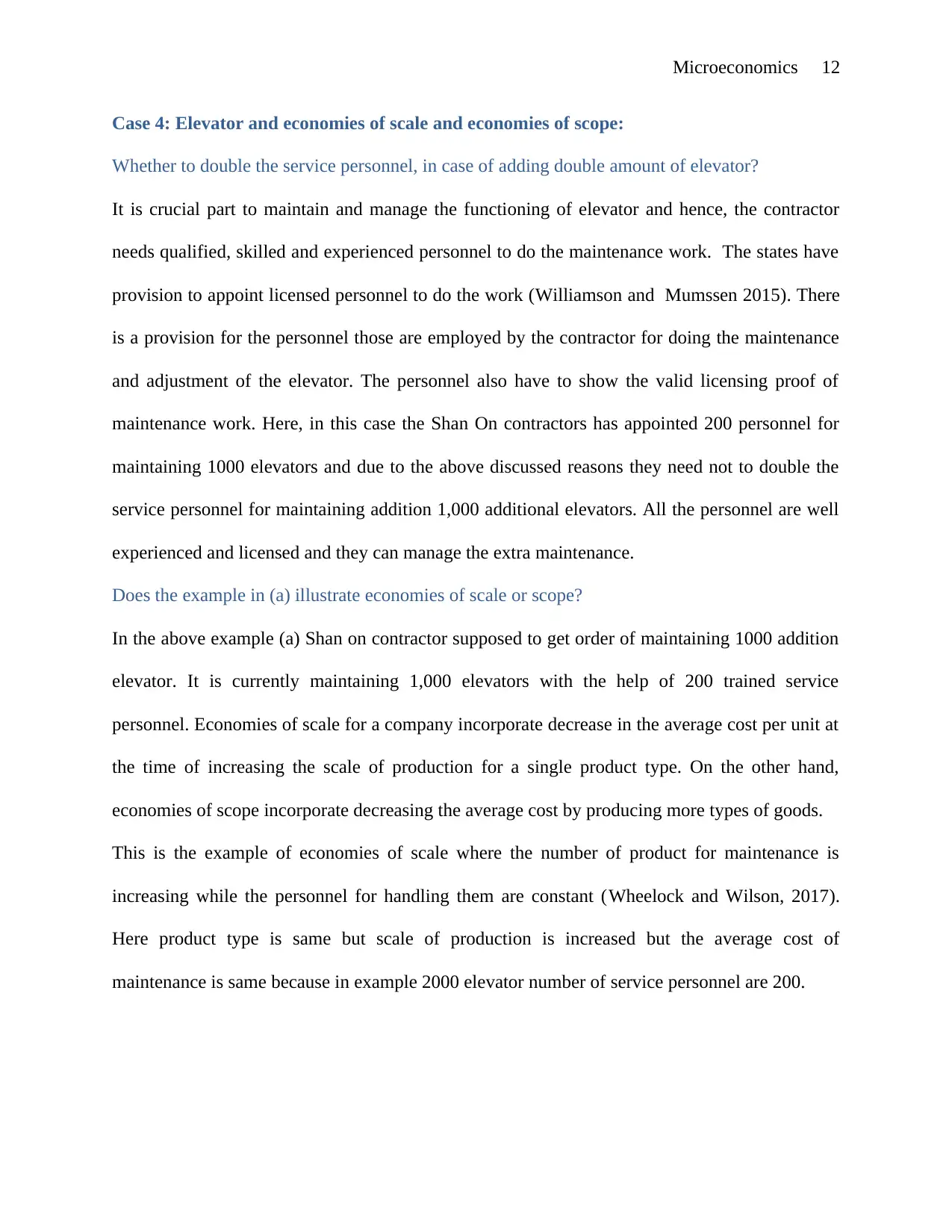
Microeconomics 12
Case 4: Elevator and economies of scale and economies of scope:
Whether to double the service personnel, in case of adding double amount of elevator?
It is crucial part to maintain and manage the functioning of elevator and hence, the contractor
needs qualified, skilled and experienced personnel to do the maintenance work. The states have
provision to appoint licensed personnel to do the work (Williamson and Mumssen 2015). There
is a provision for the personnel those are employed by the contractor for doing the maintenance
and adjustment of the elevator. The personnel also have to show the valid licensing proof of
maintenance work. Here, in this case the Shan On contractors has appointed 200 personnel for
maintaining 1000 elevators and due to the above discussed reasons they need not to double the
service personnel for maintaining addition 1,000 additional elevators. All the personnel are well
experienced and licensed and they can manage the extra maintenance.
Does the example in (a) illustrate economies of scale or scope?
In the above example (a) Shan on contractor supposed to get order of maintaining 1000 addition
elevator. It is currently maintaining 1,000 elevators with the help of 200 trained service
personnel. Economies of scale for a company incorporate decrease in the average cost per unit at
the time of increasing the scale of production for a single product type. On the other hand,
economies of scope incorporate decreasing the average cost by producing more types of goods.
This is the example of economies of scale where the number of product for maintenance is
increasing while the personnel for handling them are constant (Wheelock and Wilson, 2017).
Here product type is same but scale of production is increased but the average cost of
maintenance is same because in example 2000 elevator number of service personnel are 200.
Case 4: Elevator and economies of scale and economies of scope:
Whether to double the service personnel, in case of adding double amount of elevator?
It is crucial part to maintain and manage the functioning of elevator and hence, the contractor
needs qualified, skilled and experienced personnel to do the maintenance work. The states have
provision to appoint licensed personnel to do the work (Williamson and Mumssen 2015). There
is a provision for the personnel those are employed by the contractor for doing the maintenance
and adjustment of the elevator. The personnel also have to show the valid licensing proof of
maintenance work. Here, in this case the Shan On contractors has appointed 200 personnel for
maintaining 1000 elevators and due to the above discussed reasons they need not to double the
service personnel for maintaining addition 1,000 additional elevators. All the personnel are well
experienced and licensed and they can manage the extra maintenance.
Does the example in (a) illustrate economies of scale or scope?
In the above example (a) Shan on contractor supposed to get order of maintaining 1000 addition
elevator. It is currently maintaining 1,000 elevators with the help of 200 trained service
personnel. Economies of scale for a company incorporate decrease in the average cost per unit at
the time of increasing the scale of production for a single product type. On the other hand,
economies of scope incorporate decreasing the average cost by producing more types of goods.
This is the example of economies of scale where the number of product for maintenance is
increasing while the personnel for handling them are constant (Wheelock and Wilson, 2017).
Here product type is same but scale of production is increased but the average cost of
maintenance is same because in example 2000 elevator number of service personnel are 200.
⊘ This is a preview!⊘
Do you want full access?
Subscribe today to unlock all pages.

Trusted by 1+ million students worldwide
1 out of 15
Your All-in-One AI-Powered Toolkit for Academic Success.
+13062052269
info@desklib.com
Available 24*7 on WhatsApp / Email
![[object Object]](/_next/static/media/star-bottom.7253800d.svg)
Unlock your academic potential
Copyright © 2020–2025 A2Z Services. All Rights Reserved. Developed and managed by ZUCOL.
